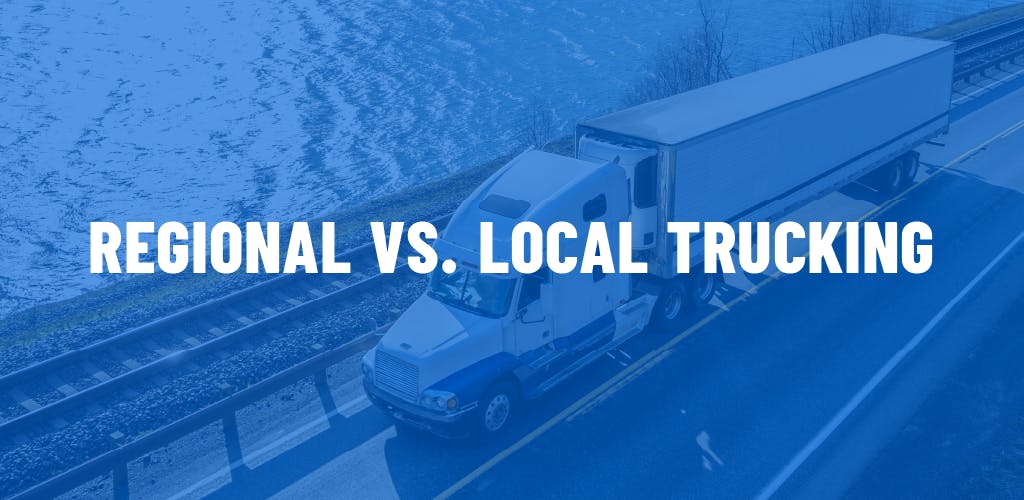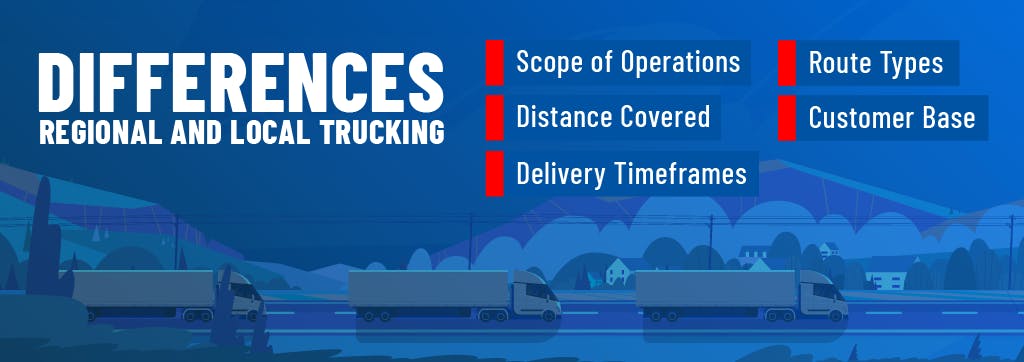Regional vs Local Trucking
October 10th, 2023

The trucking industry plays a pivotal role in the global economy, with regional and local trucking operations acting as the life-blood of a healthy economy. These operations, while distinct in their scope, collectively ensure that goods, whether perishables or electronics, reach their intended destinations in a timely and efficient manner.
This article takes a deep dive into the world of regional and local trucking, examining their core definitions, practical examples, and the subtle yet significant differences between them.
What is Regional Trucking?
Regional trucking, as the name suggests, revolves around transportation operations that cater to a specific geographical region. This region can be as expansive as covering multiple states or as confined as a few neighboring states.
Unlike local and long-haul trucking, regional trucking finds its sweet spot between the short routes of local trucking and the marathon routes of cross-country routes.
While these routes invariably cross state boundaries, regional trucking is all about bridging the gap between the short, swift routes of local trucking and the extensive, exhaustive routes of long-haul operations.
Examples of regional trucking:
- Moving electronics from Pennsylvania, ensuring they reach every nook and cranny of the Northeast.
- Ensuring the latest fashion apparel from Florida finds its way to boutique stores and major retailers across the Southeast.
- Transporting fresh agricultural produce from the fertile fields of California to bustling markets and grocery chains in the Pacific Northwest.
What is Local Trucking?
Local trucking, often perceived as the lifeblood of urban and suburban areas, is all about ensuring that goods and services move seamlessly within more confined geographical boundaries. Whether it’s the daily essentials like milk and bread or specialized items like medicines, local trucking ensures they reach consumers in a timely fashion.
Local trucking is all about immediacy; it’s about making sure that the freshly baked bread reaches the local bakery while it’s still warm or that the newly launched book is available at the local bookstore on its release day.
With routes that are meticulously planned and often repeated, drivers in local trucking operations become masters of their terrain, knowing every shortcut, every traffic pattern, and every delivery dock in their designated area.
Local trucking is the reason why local stores are always stocked, why restaurants have fresh ingredients every day, and why consumers can access a wide range of products without traveling long distances.
Examples of local trucking:
- Ensuring that the fresh produce, sourced from local farms around Atlanta, reaches supermarkets, restaurants, and homes while retaining its freshness and nutritional value.
- Facilitating the timely delivery of essential pharmaceuticals to pharmacies, clinics, and hospitals within the Boston metropolitan area, ensuring that patients have access to their medications without delay.
- Transporting a diverse range of furniture, from luxurious leather sofas to ergonomic office chairs, to residences and commercial establishments within Dallas, helping transform empty spaces into comfortable and functional environments.
Differences between Regional and Local Trucking

Regional and local trucking are two fundamental segments of the trucking industry, each with its distinct characteristics. While both are essential for transporting goods, understanding their differences is crucial for businesses, drivers, and consumers alike.
Scope of operations
Regional trucking typically covers a broader area, often spanning multiple states within a specific region of the country. It’s designed to bridge the gap between long-haul and local operations. In contrast, local trucking is more concentrated, focusing on transportation within specific cities or towns.
Distance covered
The distances in regional trucking are notably longer, often ranging from a few hundred to over a thousand miles. This is because it’s meant to serve areas that are farther apart. Local trucking, however, is all about shorter distances, usually not exceeding a hundred miles, as it’s centered around specific urban or suburban areas.
Delivery timeframes
Given the longer distances involved in regional trucking, deliveries might take several days. Factors like the specific route, traffic conditions, and the nature of the cargo can influence the timeframe. On the other hand, local trucking aims for speed and efficiency, with most deliveries being completed within a day due to the shorter distances involved.
Types of routes
Regional trucking routes are diverse. They can include highways, interstates, and sometimes even rural roads to ensure goods reach their destinations. Local trucking, given its focus on specific areas, mainly involves city streets, avenues, and other urban routes.
Customer base
The customer base for regional trucking is varied, catering to larger retailers, manufacturers, and other businesses that require goods to be transported across states. Local trucking, given its narrower operational scope, often serves local businesses, residents, and sometimes smaller manufacturers within a city or town.
Pros and Cons of Regional Trucking
Regional trucking plays a significant role in connecting different parts of a region, ensuring goods and services are transported efficiently. However, like any operation, it has its benefits and challenges.
Pros:
- Diverse customer base: By covering a larger area, regional trucking caters to a wide range of customers. This includes major retailers who need goods transported across states, as well as regional distributors who require consistent deliveries to various locations.
- Potential for higher earnings: The extended distances and larger cargo loads in regional trucking often mean better compensation for drivers. Additionally, the complexity of some routes can lead to premium pay.
- Ever-changing scenery: One of the underrated perks of regional trucking is the opportunity for drivers to witness a variety of landscapes. From bustling cities to serene countryside views, the changing backdrop can make the journey more enjoyable and less repetitive.
Cons:
- Extended periods away from home: One of the primary challenges of regional trucking is the time spent away from home. Multi-day routes can mean nights away, which can be tough for drivers with families.
- Greater wear and tear on vehicles: Covering longer distances means more time on the road, leading to faster wear and tear on trucks. This can result in more frequent maintenance checks and potential downtime.
- Fluctuating fuel costs: Longer routes mean more fuel consumption. With the ever-changing fuel prices, this can lead to unpredictable operational costs, affecting profitability.
Pros and Cons of Local Trucking
Local trucking is essential for the day-to-day operations of cities and towns, ensuring that goods are delivered promptly within a confined area. While it offers several advantages, it’s not without its challenges.
Pros:
- Daily home returns: One of the most significant benefits of local trucking is the ability for drivers to return home daily. This work-life balance is appealing to many, especially those with families.
- In-depth knowledge of local routes: Local trucking allows drivers to become experts in their designated areas. This familiarity can lead to quicker deliveries, as drivers know the best routes, traffic patterns, and delivery points.
- Consistent work hours: Unlike regional or long-haul trucking, which might have varying schedules, local trucking often has more regular and predictable work hours. This consistency can be beneficial for planning personal activities and commitments.
Cons:
- Limited growth opportunities: Given its confined operational scope, local trucking might offer fewer opportunities for business expansion or diversification.
- Potential for lower earnings: While local routes mean less wear and tear on vehicles and lower fuel costs, the shorter distances might result in lower pay compared to regional trucking.
- Repetitive routes: One of the challenges of local trucking is the repetitiveness of routes. Driving the same paths daily can become routine, lacking the variety that regional or long-haul routes might offer.
FAQ
How many miles is considered local in trucking?
Local trucking, by industry standards, generally refers to routes that don’t stretch beyond 100-150 miles from the starting point. This ensures that drivers can complete their deliveries and return to their base within the same working day. While this is a general guideline, specific definitions might vary based on company policies or specific job requirements.
How many miles can a local truck driver drive a day?
The distance a local truck driver covers in a day can vary based on several factors, including the nature of the cargo, the number of delivery stops, and prevailing traffic conditions. Typically, a local truck driver might drive between 50 to 150 miles daily. However, in densely populated urban areas with heavy traffic, the distance might be on the lower end of this range, while in suburban or rural areas, drivers might cover more ground.
What is the difference between long haul and regional?
Long-haul trucking involves coast-to-coast distances, often crisscrossing the entire nation. Regional trucking, while covering multiple states, is confined to a specific region. For a deeper dive into trucking efficiencies, consider reading our blog on semi-truck fuel efficiency.
Learn More with Hale Trailer
At Hale Trailer, we’re more than just a trailer provider. We’re your partners on the road, offering insights, equipment, and expertise to ensure your trucking operations run smoothly. Whether you’re exploring our extensive trailer inventory or seeking guidance from our seasoned experts across various locations, we’re here to assist. Dive into the world of trucking with Hale Trailer, and let’s start this journey together.
All the information on this website – https://www.haletrailer.com – is published in good faith and for general information purposes only. Hale Trailer Brake and Wheel does not make any warranties about the completeness, reliability and accuracy of this information. Any action you take upon the information you find on this website, is strictly at your own risk. Hale Trailer Brake and Wheel will not be liable for any losses and/or damages in connection with the use of our website.
